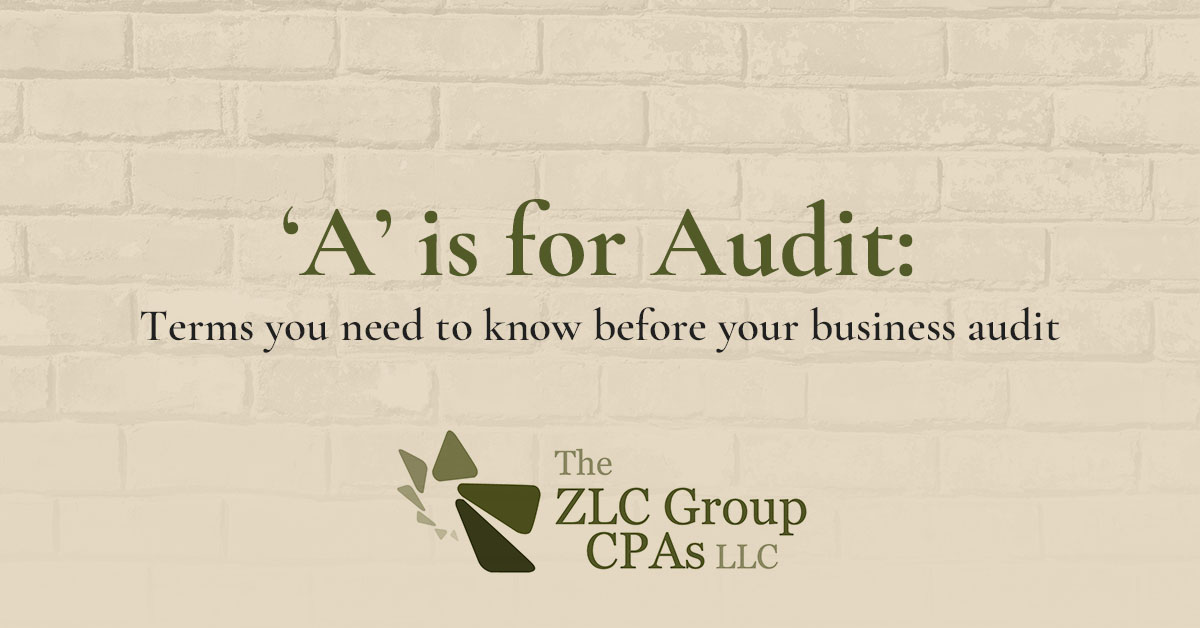It’s time to conduct an audit for your business, but which industry terms and conditions do you need to know?
Here’s a quick list of concepts to know—and tips to consider—before your business is audited this tax season.
AUDIT: a systematic review of your business transactions; a review of your financial records to verify whether they are accurate (typically conducted once per year).
There are three different types of audits:
- Internal – conducted by you or someone in your business
- External – conducted by a third-party auditor
- Government – conducted by a government agency
To prepare for your audit, make sure you:
- Calculate the most accurate numbers (do not round up or down)
- Track your deductions, but don’t deduct anything of outrageous or irrelevant value
- Present all facts and figures legibly
- Save all checks, sales slips, invoices, and receipts
- Share business logs, diaries, appointment books, and calendars
- Keep business equipment and auto records
- Document business travel and meal expenses
AUDIT EVIDENCE: facts and figures identified during the audit; used to help auditors form an opinion regarding financial statements.
Audit evidence can include:
- Financial statements
- Accounting info
- Bank accounts, statements, or confirmations
- Management accounts
- Registers and ledgers
- Payroll listings
- Invoices and receipts
There are seven different ways auditors collect audit evidence:
- Inspection – looking at physical assets, records, or documents
- Observation – looking at business processes and operations
- External confirmation – reaching out to third parties to verify information
- Recalculation – pairing third-party calculations next to yours
- Reperformance – conducting business tasks as listed to identify deficiencies
- Analytical procedures – analyzing your financial records to find discrepancies
- Inquiry – talking with your senior management to understand your business
AUDIT PLAN: an outline of audits to be conducted over a pre-set period of time; includes description, schedule, scope of work, and objectives.
To build an audit plan:
- Define audits to be performed – What are you auditing?
- Prioritize risk assessments – What risks do you need to address?
- Designate resources – Who will work on your audit?
- Establish a timeline – When will you (or a third party) conduct your audit?
- Set up planning meetings – Which stakeholders need to be involved?
AUDIT PROGRAM: policies and procedures that govern the audit process.
AUDIT RISK: a potential instance wherein financial statements are deemed erroneous or fraudulent
There are three different types of audit risk:
- Inherent risk – the likelihood that your audit will be deemed inaccurate based on the nature of your business
- Control risk – the likelihood that your internal controls won’t detect or prevent mistakes
- Detection risk – the likelihood that a third-party auditor won’t detect or prevent mistakes
Other important audit terms and conditions include:
CHARTER: a document approved by major company stakeholders; defines responsibilities and authorities for all audit functions.
CONTROLS: methods put into place to preserve the integrity of information, meet objectives, and/or communicate policies; see also: secondary control; see also: tertiary control
DUE PROFESSIONAL CARE: the process of gathering evidence to support the financial statements of your business; see also: controls; a.k.a. governance
GENERALLY ACCEPTED ACCOUNTING PRINCIPLES (GAAP): standard U.S. guidelines for accounting activities when conducting audits.
GENERALLY ACCEPTED AUDITING STANDARDS (GAAS): standard U.S. guidelines for auditing activities when conducting audits.
GOING CONCERN: the expectation that your business will continue to operate for at least 12 more months.
INDEPENDENCE: the absence of a close or special relationship between auditor and audited.
LIKELIHOOD: the probability of a risk occurring; see also: inherent risk.
MANAGEMENT ASSERTIONS: claims made by management regarding aspects of a business; used by auditors to test the validity or accuracy of an audit.
MATERIALITY: a concept used to describe the importance of an audit item; i.e., the more material something is, the more of an impact it will have on your audit.
OPINION: the statement expressed by an independent auditor at the conclusion of an audit.
There are four possible opinion outcomes:
- Adverse audit opinion – indicates that financial statements have been misrepresented
- Disclaimer of audit opinion – indicates that the auditor is distancing themselves from offering a formal opinion on the financial statements provided
- Financially unqualified audit opinion – indicates that the auditor is satisfied with the financial statements provided, a.k.a. a clean report
- Qualified audit opinion – indicates that audit controls were ineffective
PROFESSIONAL SKEPTICISM: the process of approaching an audit with a questioning mind.
SAMPLING: the process of selecting a small but appropriate number of records to represent all of the records.
WORKPAPERS: documents that list all activities and evidence obtained during an audit.
Need a hand with your business audit?
We can help! Call us at 716.839.9001 or contact us online today!



